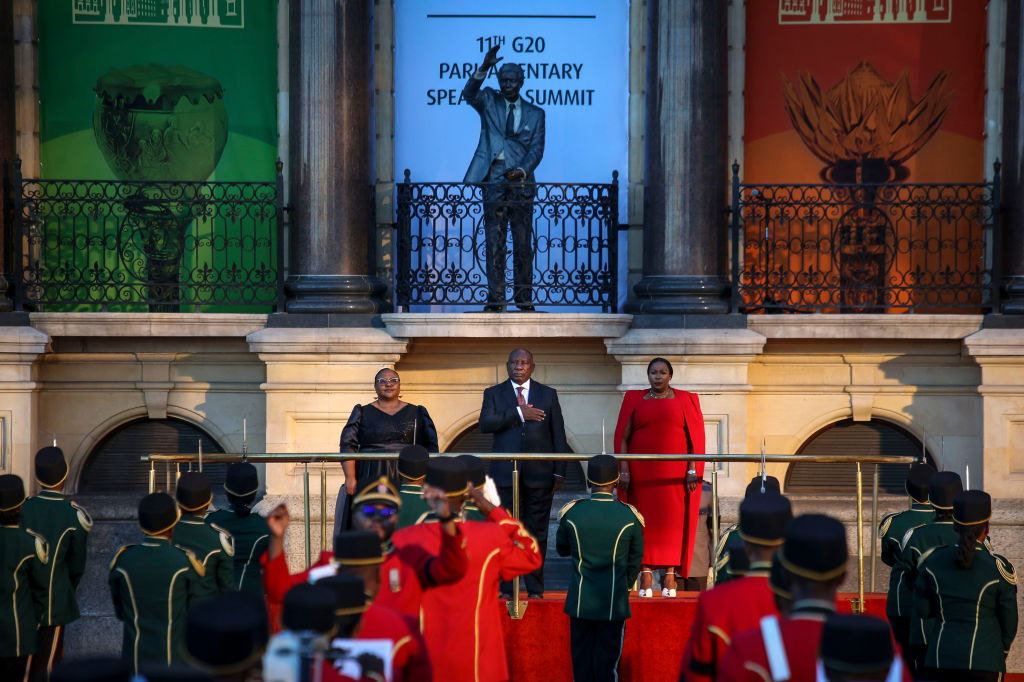President Cyril Ramaphosa delivered his 2025 State of the Nation Address (SONA) against the backdrop of South Africa’s evolving political and economic realities. Addressing Parliament in Cape Town City Hall today, he outlined an ambitious framework for national renewal, emphasizing economic revitalization, infrastructure investment, and the country’s place in the shifting global order.
The address came at a critical moment: the first full year of South Africa’s Government of National Unity (GNU), rising geopolitical tensions, and an economy striving to recover from years of stagnation. While Ramaphosa painted a picture of resilience and reform, the challenges of implementation remain a formidable test.
Economic Recovery And Infrastructure
Ramaphosa placed economic growth and job creation at the heart of his administration’s priorities. “Our most urgent task is to grow our economy so we can create jobs, reduce poverty, and improve the lives of all South Africans,” he stated, setting a 3% GDP growth target as a crucial milestone. However, this target may be difficult to achieve given existing economic constraints.
South African economist Dawie Roodt offers a measured perspective. “If we get kicked off AGOA, it’s not the end of the world, but everything adds up. We could see economic growth well below 1.5%, and that will have serious consequences,” he tells FORBES AFRICA. While the government’s infrastructure plans are extensive, structural challenges may pose obstacles to reaching this ambitious growth rate.
Loading...
With GDP growth struggling to surpass 1.5% in recent years, achieving the government’s 3% target will be a significant challenge. While infrastructure spending is a key strategy, Roodt cautioned that it alone may not be enough to drive the necessary economic expansion.
To stimulate growth, his government has committed to a R940 billion ($51 billion) infrastructure investment over three years, including R375 billion ($20.3 billion) in spending by state-owned enterprises (SOEs). Projects range from modernizing ports and railways to the completion of the Polihali Dam in the Lesotho Highlands, ensuring water security for key industrial hubs.
Infrastructure reform extends to energy, where South Africa’s ongoing transition away from Eskom’s monopoly is set to redefine the electricity sector. “We must put the risk of loadshedding behind us once and for all,” Ramaphosa affirmed, touting the Electricity Regulation Amendment Act, which enables private investment in generation and transmission networks. The government also aims to mobilize over $13 billion in international climate funding to support the Just Energy Transition (JET).
State Capacity And Governance Reform
Ramaphosa acknowledged the systemic failures in public service delivery, from failing municipalities to persistent corruption in state institutions. Acknowledging the urgent need for reform, he announced a new model for public service recruitment, strengthening the Public Service Commission’s role in appointing directors-general and SOE executives.
Municipal service failures remain a pressing concern, with unmaintained roads, disrupted electricity, and inadequate water provision plaguing local governance. In response, the government will establish ring-fenced utilities for water and electricity in struggling municipalities to ensure revenue is reinvested into infrastructure.
South Africa–U.S. Relations And Foreign Policy
The speech took on a notable diplomatic tone, reflecting South Africa’s role in an increasingly fragmented global order. Ramaphosa reaffirmed South Africa’s commitment to multilateralism, highlighting its G20 presidency as an opportunity to champion Africa’s economic interests on the global stage.
However, relations with the U.S. remain complex. The Biden administration’s recent decision to suspend some HIV and TB program funding for Africa — which accounts for 17% of South Africa’s HIV spending — was met with concern. “We are looking at various interventions to address the immediate needs and ensure the continuity of essential services,” Ramaphosa stated, underscoring the country’s reliance on international partnerships.
South Africa’s stance on Palestine and its International Court of Justice (ICJ) case against Israel has also drawn U.S. scrutiny. While South Africa upholds its position on human rights and territorial sovereignty, Washington’s view on the country’s geopolitical alignment remains cautious, particularly given its engagement with BRICS and growing economic ties with China and Russia.
Jobs, Trade, And Business Confidence
Addressing unemployment, particularly among youth, Ramaphosa reaffirmed the expansion of the Presidential Employment Stimulus, which has created 2.2 million work opportunities. However, he emphasized that private-sector growth is crucial to sustainable employment, urging businesses to engage with the SAYouth.mobi platform and expand workplace experience programs.
On trade, the African Continental Free Trade Area (AfCFTA) remains a pillar of South Africa’s economic strategy. With the country positioning itself as a regional hub for green manufacturing, electric vehicles, and digital services, Ramaphosa reiterated South Africa’s ambition to lead Africa’s industrialisation wave.
Economist Roodt further emphasizes the risks beyond trade: “If the U.S. stops buying our government bonds, that’s when we’ll be in real trouble. The rand will tank, inflation will spike, and the entire financial system could come under strain.”
The mining sector, a historical backbone of the economy, is also poised for reform. A modernized mining rights system, expected this year, aims to unlock investment in exploration and critical minerals, strengthening South Africa’s position in the global commodities market.
Challenges Ahead
Despite the optimistic tone, economic realities pose significant risks. With GDP growth struggling to surpass 1.5% in recent years, achieving the 3% target will require more than infrastructure spending. Structural challenges — from inefficiencies in SOEs to regulatory red tape — continue to hamper investor confidence.
Furthermore, political stability within the GNU remains untested. With ideological differences between the ANC, DA, IFP, and other coalition partners, policy coherence will be a major determinant of success.
Ramaphosa’s message was clear: South Africa has the potential to emerge stronger, but execution will determine its trajectory. Whether the government’s ambitious reforms translate into real economic growth and global competitiveness will be the ultimate test.
Loading...
